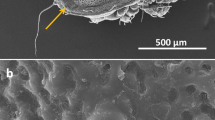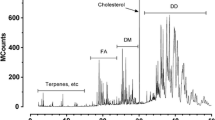Abstract
The chemistry of the lemon-scented oil gland secretion ofCollohmannia gigantea, a middle-derivative mixonomatanoribatid mite, was investigated by gas chromatography – massspectrometry.Gas chromatographic profiles of whole body extracts of C.gigantea revealed two distinct chromatographic zones, the firstcontaining a set of six volatile compounds, comprising the lemon-scentedmonoterpene aldehydes neral and geranial, the scented monoterpene ester nerylformate, a distinctly scented aromatic aldehyde(2-hydroxy-6-methyl-benzaldehyde= 2,6-HMBD), and the two non-scented hydrocarbons, tridecane and pentadecane.All six components appeared to be present in steady relative proportions inscenting mites only, indicating their unity within the scented secretion. Incontrast, the components of the second chromatographic zone were less volatileand found in both, scenting and non-scenting mites. Chemically, they representaset of fatty acids of already known cuticular origin.
The secretion bouquet ofthe first chromatographic zone was linked with oil glands by histochemicalmeans: large amounts of aldehydes were present only in oil gland reservoirs,notin any other region of the mite body. While chemical profiles of oil glandsecretions of several dozen astigmatid mites are known, only one other oribatidoil gland composition, from a desmonomatan species, has been elucidated, beingalmost the same as that of C. gigantea. Moreover, allcomponents of these two secretions are widely distributed amongst astigmatidmite species and may also be common in a restricted set of middle-derivativeoribatids. These findings are consistent with the idea of astigmatid miteoriginfrom a mixonomatan-desmonomatan group.
Similar content being viewed by others
References
Alberti G. and Coons L.B. 1999. Acari: Mites. In: Harrison F.W. and Foelix R.F. (eds), Microscopic Anatomy of Invertebrates, Vol. 8C, Chelicerate Arthropoda. Wiley-Liss, New York, pp. 515–1265.
Brody A.R. and Wharton G.W. 1970. Dermatophagoides farinae: ultrastructure of lateral opisthosomal dermal glands. Trans. Amer. Microsc. Soc. 89: 499–513.
Bull J.O. 1970. Deal with insect pests this way. Food Manufacture 45: 46.
Chatterjea J.N., Singh K.R.R.P., Jha I.S., Prasad Y. and Shaw S.C. 1986. Synthesis of gerberinol I. Ind. J. Chem. 25B: 796–798.
Dickinson R.G. and Jacobsen N.W. 1970. A new sensitive and specific test for the detection of aldehydes; formation of 6-mercapto-3-substituted-s-triazolo (4,3b)-s-tetrazines. Chem. Comm. 1970: 1719–1720.
Durst H.D. and Gokel G.W. 1978. A classification test for aldehydes involving phase transfer catalysis. J. Chem. Edu. 55: 206.
Grafe J. and Engelhardt H. 1972. Einfluß der Polyamidstruktur bei der Dünnschicht-Chromatographie von Zuckern. Chromatographia 5: 307.
Grandjean F. 1950. Observations sur les oribates (21e serie). Bull. Mus. Nat. Hist. Natur. 22: 344–351.
Krantz G.W. 1978. A Manual of Acarology. Oregon State University Book Stores, Inc., Corvallis.
Kuwahara Y. 1976. Alarm pheromones produced by several grain mites. In: Proceedings of a Symposium on Insect Pheromones and their Applications. Agriculture, Forestry and Fisheries Council, Ministry of Agriculture and Forestry, Japan, pp. 65–75.
Kuwahara Y. 1991. Pheromone studies on astigmatid mites-alarm, aggregation and sex. In: Dusbabek F. and Bukva V. (eds), Modern Acarology. Vol. I. SPB Academic Publishing, The Hague, pp. 43–52.
Kuwahara Y. and Sakuma L. 1982. Pheromone study on acarid mites. IX. Synthesis of alarm pheromone analogues of the mold mite, Tyrophagus putrescentiae, and their biological activities. Agr. Biol. Chem. 46: 1855–1860.
Kuwahara Y., Ishii S. and Fukami H. 1975. Neryl formate: alarm pheromone of the cheese mite, Tyrophagus putrescentiae (Schrank) (Acarina, Acaridae). Experientia 31: 1115–1116.
Kuwahara Y., Akimoto K., Leal W.S., Nakao H. and Suzuki T. 1987. Isopiperitenone: a new alarm pheromone of the acarid mite, Tyrophagus similis (Acarina, Acaridae). Agric. Biol. Chem. 51: 3441–3442.
Kuwahara Y., Shibata C., Akimoto K., Kuwahara M. and Suzuki T. 1988. Pheromone study on acarid mites. XIII. Identification of neryl formate as an alarm pheromone from the bulb mite, Rhizoglyphus robini (Acarina: Acaridae). Appl. Ent. Zool. 23: 76–80.
Kuwahara Y., Koshii T., Okamoto M., Matsumoto K. and Suzuki T. 1991. Chemical ecology on astigmatid mites. XXX. Neral as the alarm pheromone of Glycyphagus domesticus (De Geer) (Acarina: Glycyphagidae). Jap. J. San. Zool. 42: 29–32.
Kuwahara Y., Ohshima M., Sato M., Kurosa K., Matsuyama S. and Suzuki T. 1995. Chemical ecology of astigmatid mites. XL. Identification of the alarm pheromone and new C17 hydrocarbons from Tortonia sp., a pest attacking the nests of Osmia cornifrons. Appl. Ent. Zool. 30: 177–184.
Michael A.D. 1884. British Oribatidae. Vol. I. The Ray Society, London.
Norton R.A. 1994. Evolutionary aspects of oribatid mite life-histories and consequences for the origin of the Astigmata. In: Houck M. (ed.), Mites: Ecological and Evolutionary Analyses of Life-history Patterns. Chapman & Hall, New York, pp. 99–135.
Norton R.A. 1998. Morphological evidence for the evolutionary origin of Astigmata (Acari: Acariformes). Exp. Appl. Acarol. 22: 559–594.
Raspotnig G. and Krisper G. 1998. Fatty acids as cuticular surface components in oribatid mites (Acari: Oribatida). In: Ebermann E. (ed.), Arthropod Biology: Contributions to Morphology, Ecology and Systematics. Austrian Academy of Sciences Press, Vienna, pp. 215–243, Biosyst. Ecol. Ser.
Riha G. 1951. Zur Ökologie der Oribatiden in Kalksteinböden. Zool. Jb. Syst. Abt. 80: 407–450.
Sakata T., Tagami K. and Kuwahara Y. 1995. Chemical ecology of oribatid mites. I. Oil gland components of Hydronothrus crispus Aoki. J. Acarol. Soc. Jpn. 4: 69–75.
Schuster R. 1962. Nachweis eines Paarungszeremoniells bei den Hornmilben. Naturwissenschaften 21: 502–503.
Sellnick M. 1922. Milben der Sammlung des Deutschen Entomologischen Instituts. I. Oribatidae. Entomol. Mitt. part II: 17–22.
Shimano S., Sakata T., Mizutani Y., Kuwahara Y. and Aoki J. 2001. An alarm pheromone function of the secretion from the nymphal stage of the oribatid mite Nothrus palustris (C.L. Koch) (Acari: Nothridae). In: Halliday R.B., Walter D.E., Proctor H.C., Norton R.A. and Colloff M.J. (eds), Acarology: Proceedings of the 10th International Congress. CSIRO Publishing, Melbourne, pp. 250–252.
Smrz J. 1992. Some adaptive features in the microanatomy of moss-dwelling oribatid mites (Acari: Oribatida) with respect to their ontogenetical development. Pedobiologia 36: 306–320.
Tongu Y., Ishii A. and Oh H. 1986. Ultrastructure of house dust mites, Dermatophagoides farinae and D. pteronyssinus. Jap. J. Sanit. Zool. 37: 237–244.
Van der Hammen L. 1980. Glossary of Acarological Terminology. General terminology. Vol. I. Junk BV publishers, The Hague.
Vitzthum H. 1931. Acari. In: Kükenthal W. and Krumbach T. (eds), Handbuch der Zoologie 3/2/1. De-Gruyter, Berlin, pp. 1–160.
Vitzthum H. 1940–1943. Acarina. In: Bronn's Klassen und Ordnungen des Tierreichs 5/4/5. Akademische Verlagsgesellschaft, Leipzig, pp. 1–1011.
Woodring J.P. and Cook E.F. 1962. The internal anatomy, reproductive physiology and moulting process of Ceratozetes cisalpinus (Acarina: Oribatei). Ann. Ent. Soc. Am. 55: 164–181.
Author information
Authors and Affiliations
Rights and permissions
About this article
Cite this article
Raspotnig, G., Schuster, R., Krisper, G. et al. Chemistry of the oil gland secretion of Collohmannia gigantea (Acari: Oribatida). Exp Appl Acarol 25, 933–946 (2001). https://doi.org/10.1023/A:1020634215709
Issue Date:
DOI: https://doi.org/10.1023/A:1020634215709




